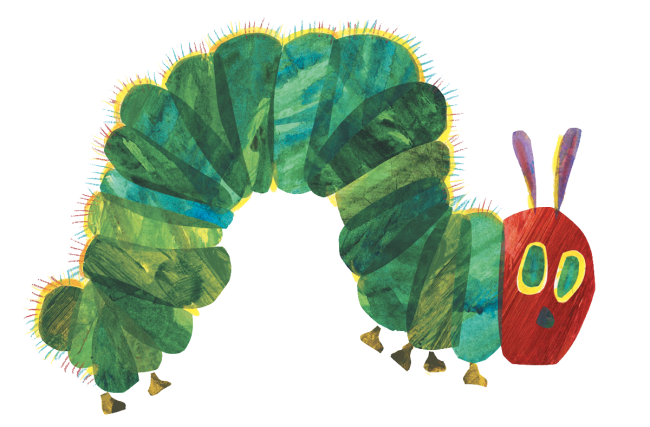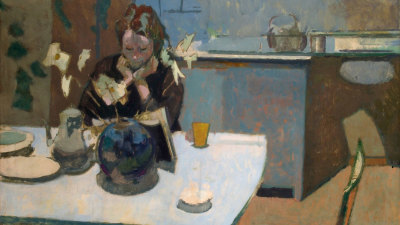The artists behind your favourite childhood books
The artists behind your favourite childhood books
By Sandra MacKenzie
Published 25 August 2017
How much do you know about the illustrators who brought your favourite childhood characters to life?
-
The books we read as children stay in our minds long after the last time we turn the pages. Characters like the Hungry Caterpillar and the Enormous Crocodile, Aslan and the Gruffalo, can be instantly pictured by readers across generations – but the stories of the people who first gave them shape are often less well-remembered.
To coincide with the work of one such illustrious illustrator, Charles Tunnicliffe RA being shown in our Tennant Gallery, we took a closer look at some of the artists responsible for drawing our favourite childhood characters.
Please note that this exhibition has now closed.
-
-

Peggy Fortnum
Ever since he arrived from deepest, darkest Peru with a label asking “Please look after this bear”, Michael Bond’s Paddington Bear has been beloved by children everywhere. He’s gone on to take both small and silver screens by storm – but it was Peggy Fortnum’s pen-and-ink drawings that first conjured him into life in 1958.
Fortnum’s lively, loose drawings perfectly complemented Paddington’s charm, innocence and endearing clumsiness. “I always saw Paddington as a real being,” she said, “I don’t like whimsy or sentiment. This bear had character.”
Fortnum never begrudged being so inextricably linked with just one of her 80-plus projects, faithfully illustrating her replies to fan mail with little sketches of Paddington Bear, clutching his hat while dashing off for the next adventure.
Original Peggy Fortnum PADDINGTON BEAR™ © Paddington and Company Ltd 201* From the Paddington Bear books by Michael Bond Illustrated by Peggy Fortnum Paddington Bear™, Paddington™ and PB™ are trademarks of Paddington and Company Limited
-
-
-
Hilary Knight
Written by Kay Thompson and animated by Hilary Knight’s illustrations, Eloise’s rampages round the New York’s Plaza Hotel drew legions of “precocious grown-up” fans, including Susan Sarandon, Lena Dunham and Maurice Sendak. She even won over the Plaza itself – the hotel granted her author rent-free accommodation for almost 20 years.
When Thompson decided abruptly to pull the fifth Eloise and stop publishing all but one book in the 1960s, Knight had to stop drawing her. However, his output since has been equally iconic – an exhibition of his original Broadway posters, including Half a Sixpence, Oklahoma! and Gypsy, opened this year in New York.
The abandoned Eloise book was finally published in 2002, and its six-year-old star is back in pride of place on bookshelves worldwide.
Kay Thompson’s Eloise at the Plaza, illustrated by Hilary Knight. Reprinted with permission of Little Simon, Simon & Schuster. Copyright © 1955 by Kay Thompson. Copyright renewed © 1983 by Kay Thompson.

-
-
-

Eric Carle
It’s been translated into 30 languages, performed at the Royal Opera House and, by some estimates, sold a copy a minute since it was published. The Very Hungry Caterpillar is an astonishing success story, but it’s also one of over 75 books by author and illustrator Eric Carle. His personal favourite is 1971’s Do You Want To Be My Friend?
Initially bemused by his greedy caterpillar’s popularity, Carle told the Guardian in 2004 that he understood it conveyed a message of hope. “It says, you’ll grow up and you’ll be alright – and not just alright, you’ll be beautiful".
The Very Hungry Caterpillar by Eric Carle, Copyright ©1969 and 1987 by Eric Carle. All rights reserved. Used with Permission from the Eric Carle Studio.
-
-
-
Eileen Soper
Eileen Soper first exhibited in the Royal Academy’s Summer Exhibition when she was only a teenager. Her etchings proved hugely popular with the public, and she was already an established artist when she began a 25-year collaboration with Enid Blyton in 1941.
The success of Five on a Treasure Island encouraged Blyton to expand, eventually publishing 21 Famous Five books. Soper illustrated them all, but reportedly didn’t particularly enjoy the work, irritated by Blyton’s demanded amends to drawings that Soper considered finished.
Soper and her sister Eva lived together in rural Hertfordshire for almost their entire lives, focusing their art on the natural world around them. A founder member of the Society of Wildlife Artists, Soper illustrated several nature books and even appeared on the BBC’s Animal Magic, showing off tame birds from her garden eating from her hand.
Five on a Treasure Island by Enid Blyton, illustrated by Eileen Soper. Permission granted by Hodder & Stoughton Ltd (Enid Blyton Estate). The Famous Five ® and Enid Blyton ® are registered trademarks of Hodder and Stoughton Limited. © 2017 Hodder & Stoughton Limited. All rights reserved.

-
-
-

Axel Scheffler
According to his biography, we have a cuddly purple cow to thank for the award-winning career of German illustrator Axel Scheffler. Although he always liked art, he wasn’t sure he was good enough to pursue it professionally – until he won the toy for coming first in a drawing competition.
In the years since, Scheffler has written his own Pip and Posy series and collaborated with writer Julia Donaldson on The Gruffalo, Room on the Broom, The Snail and the Whale and many more. During the Brexit referendum campaign, Scheffler made a passionate argument for Remain, even recasting his Gruffalo as a mythical “Brusselo” bogeyman for a Guardian cartoon.
Image from The Gruffalo © Julia Donaldson and Axel Scheffler 1999. By kind permission of Macmillan Children’s Books
-
-
-
Ezra Jack Keats
Capturing the magic of waking up to a world covered in snow, The Snowy Day by Ezra Jack Keats was also the first full-colour picture book with a black protagonist. Keats drew Peter after realising “none of the manuscripts I’d been illustrating featured any black kids… My book would have him there simply because he should have been there all along.”
Born in New York to Polish-Jewish parents as Jacob Ezra Katz, Keats changed his name in 1947 to avoid antisemitism. The Great Depression and WWII sidelined his artistic ambitions, but by the ‘50s he was a working illustrator and wrote his first book, The Snowy Day, in 1962. Its success proved that children everywhere identified with Peter’s wonderment, while also introducing many readers to their first character who looked like them.
The Snowy Day by Ezra Jack Keats, www.ezra-jack-keats.org. Used with permission of the Ezra Jack Keats Foundation.

-
-
-

Charles Tunnicliffe RA
The Ladybird books What to Look for in Autumn, Winter, Spring and Summer, currently exhibited in Second Nature: The Art of Charles Tunnicliffe RA, introduced generations of children to the wonders of the natural world. A devoted naturalist himself, Tunnicliffe was the perfect guide on this quest – his drawings reflect an enduring fascination with wildlife.
Intricately detailed and full of life, Tunnicliffe’s illustrations developed over hours of observation, supplemented by the measured drawings he made of specimens he spotted on his walks. From his home on Anglesey, Tunnicliffe closely studied the diverse birds of the island, finding himself so delighted by watching peregrines in flight when he first moved there that he “could hardly eat sandwiches”.
Charles Tunnicliffe RA, Wild rose, briar rose and elderflower on a stone wall (from What to Look for in Summer, detail) 1960. www.vintageladybird.com © Ladybird Books Ltd, 1960. Reproduced by kind permission of Ladybird Books Ltd
-
-
-
Pauline Baynes
The Chronicles of Narnia and The Lord of the Rings are two of the world’s most enduring fantasy series – and both have the same woman to thank for the first-ever depictions of their enchanting worlds. In addition to illustrating all seven Chronicles, Pauline Baynes designed the first cover of The Hobbit and literally drew the map of Middle Earth.
JRR Tolkien insisted on working with Baynes after seeing her drawings by chance at his publisher. Tolkien also provided the introduction to CS Lewis, although the latter proved harder to please, once claiming that “She can’t draw lions, but she is so good and beautiful and sensitive that I can’t tell her this.” Regardless, it was Baynes who was asked to provide colour versions of her drawings for a new edition released in 1998 – over 40 years after she first drew Narnia.
Illustration by Pauline Baynes © copyright CS Lewis Pte Ltd 1950. THE LION, THE WITCH AND THE WARDROBE by C.S. Lewis copyright © C.S. Lewis Pte. Ltd. 1950. Reprinted by permission.

-
-
-

Nick Sharratt
As Jacqueline Wilson tells it, Nick Sharratt has his bright canary-yellow socks to thank for their long and fruitful creative partnership. The author was initially concerned that Sharratt was too serious to bring her wacky Tracy Beaker to life, but changed her mind after catching sight of his flamboyant footwear.
Born in London in 1962, Nick Sharratt credits inspirations as diverse as L.S. Lowry, Pop Art, Janet and Allan Ahlberg and Abba for shaping his distinctive style.
He’s illustrated almost 250 books and written around 40 of his own, but still says his proudest achievement was receiving a gold Blue Peter badge in 2009.
Artwork Nick Sharratt, from The Story of Tracy Beaker by Jacqueline Wilson. Published by Yearling. Reprinted by permission of The Random House Group Limited © 1992
-
-
-
Sir Quentin Blake
The partnership between Quentin Blake and Roald Dahl produced some of literature’s most immediately recognisable characters, from child genius Matilda to the hideous Twits. A Cambridge graduate who never formally studied art, Sir Quentin Blake was the first ever Children’s Laureate, is an Honorary Fellow of the RA and one of a handful of foreigners to have received the Legion d’Honneur from the French government.
In 2014 Blake founded the House of Illustration, the only gallery in the UK dedicated exclusively to illustration. He turned 84 this year, but remains a prolific author, illustrator and artist – three of his recent works were shown in the 2017 Summer Exhibition.
Sir Quentin Blake, Mr Magnolia, 2010. Published by Red Fox. Reprinted by permission.

-
-
-

Walter Crane
Born in 1845, Walter Crane is credited with helping to establish children’s book illustration as an outlet for serious artistic talent. From the 1860s onwards, he illustrated a series of what were then known as “toybooks”– full-colour books for children, telling stories such as Aesop’s Fables, Beauty and the Beast and many of Grimms’s fairytales.
His style was popular enough to inspire imitation, prompting Crane to begin producing and selling his own wallpaper and textile designs. Alongside artist William Morris and writer John Ruskin, Crane was a leading figure in the British Arts and Crafts movement, founded to champion craftsmanship and traditional skills in the face of industrialisation.
He argued passionately that the decorative arts were not inferior to painting or sculpture, stating that those forms could not exist “where there is no beauty in everyday things.”
Jack escaping with the golden harp, illustrated by Walter Crane. Printed by Edmund Evans. Published by George Routledge and Sons. Photo: R.A. © Royal Academy of Arts, London.
-
-
Charles Tunnicliffe RA: Second Nature is in the Tennant Gallery at the Royal Academy until 8 October 2017. Visit the gallery’s family corner for special activities and books for younger visitors, inspired by the birds and animals in the exhibition.














